应用化学专业英语翻译Research-and-Development
- 格式:docx
- 大小:22.50 KB
- 文档页数:7
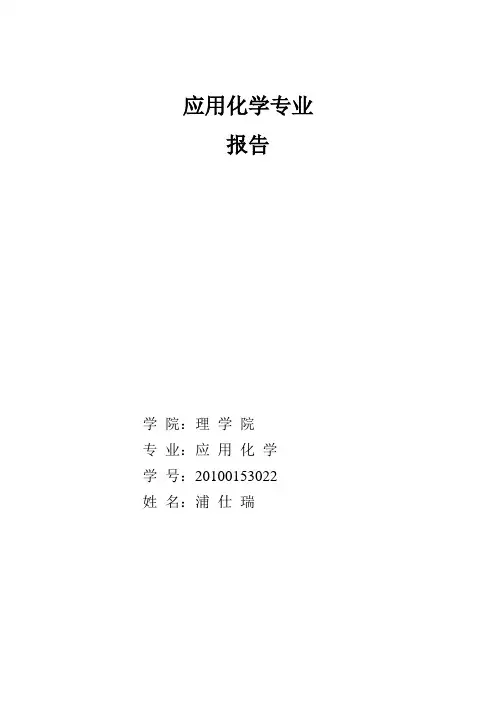
应用化学专业报告学院:理学院专业:应用化学学号:*****************Applied chemistry specialityOne、applied chemistry speciality - main courses: Training target:This specialized raise has the chemical basic theory, basic knowledge in strong experimental skills, can in scientific research institutions, colleges and universities and enterprises and institutions, engaged in scientific research, teaching and management work of the senior specialized talents.Training requirements:Students of this specialty mainly study the basic knowledge of chemistry, the basic theory, basic skills and related engineering knowledge, is the basic research and applied basic research of scientific thought and scientific experiment training, has good scientific literacy, have use knowledge and experimental skills in applied research, technology development and technology management of the basic skills.Main courses:Main subject: chemicalMain course:Inorganic chemistry、, analytical chemistry (including instrument analysis), organic chemistry, physical chemistry (including structural chemistry, chemical engineering foundation and chemical mapping.The main practice teaching links include production practice, graduation thesis, general arrangement and a week of twenty.Length of schooling: four yearsawarded degree:physical or Bachelor'sSimilar professional:chemical applied chemistry chemical biology molecular science and engineering chemical engineering and technology Two、Four chemistry:(Inorganic chemistry, analytical chemistry, organic chemistry, physical chemistry)Inorganic chemistry:Inorganic chemistry relative to organic chemistry, the non carbon. However, some carbon compounds, such as carbon monoxide, carbon dioxide, carbon disulfide, carbonic acid compounds,cyanide and so on are still belongs to the category of inorganic chemistry. analytical chemistry:Analytical chemistry in chemistry basic theory and experiment technology as the foundation, and absorb the physical, biological, statistics, computer, automation and other aspects to enrich itself, so as to solve the content of science and technology proposed all sorts of analysis.The task of analytical chemistry(1) determining the material chemical composition, qualitative analysis(2) measurement of different components of content - quantitative analysis(3) characterization of physical chemical structure, form, energy state, structure analysis, the shape analysis, energy state analysis(4) representation composition, content, structure, form, energy state dynamics characteristics, dynamic analysisorganic chemistry:Organic chemistry is the study of organic compounds and a basic subject. It mainly includes the organic compound classification, structure, naming, property, preparation, chemical reaction and reaction mechanism of law. Organic chemistry is an important branch of chemistry, it is at the molecular level teaching carbon molecular structure and their mutual conversion mechanism, products and their separation, identification and application of basic science, chemistry, biology, pharmacy, medicine, agriculture, environment, materials science support discipline. Is to create new material is an important subject. physical chemistry:Physical chemistry is a physical principle and experiment technology as the foundation, study the properties and behavior of chemical system, found and the establishment of physical chemistry chemical system of the special law of discipline. With the rapid development of science and the mutual infiltration between subjects, physical chemistry and physics, inorganic chemistry, organic chemistry in the content are difficult to accurately demarcation line, so as to constantly create new branches, such as physical organic chemistry, biology, physics chemistry, chemical physics.Three、Applied chemistry specialty elective course: Organic synthesis, botany, colloid and surface chemistry, food chemistry, ecology, the university physics, management, professional English, plant chemistry, biological chemistry, polymer chemistry, and so on.Four、Professional teachers:Li yuqing、Li xianghong、Fuhui、Li huijuan、Liming、Liu shouqing、Liangkun、Chen yuhui、Leiran、and so on.Five、Applied chemistry employment direction:Applied chemistry professional graduates suitable to the petroleum chemical industry, environmental protection, commodity inspection, health and epidemic prevention, customs, medicine, fine chemical plant and other production, technical and administrative departments and the factories and mines enterprises engaged in applied research, technology development, production technology and management work; Can also to scientific research department and school engaged in scientific research and teaching work,。
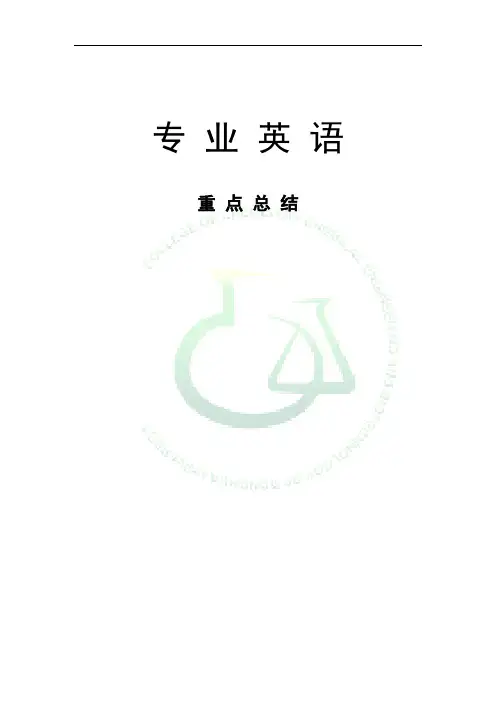
专业英语重点总结单词Toxic chemicals:有毒化学品 Chemical pollution:化学污染Physical property :物性 Isolate:分离Determine:测定 Synthesize:合成Fundamental principles:基本原理 Investigation:研究Utilize:利用 Catalyst 催化剂Enzyme 酶 Biosphere 生物圈Heterogeneous catalyst 非均相催化剂 Nanotechnology 纳米技术Carbon monoxide 一氧化碳 Chemical formulas:化学式anion: 阴离子 Oxidation number:氧化值sulphate: 硫酸盐 Hydrides: 氢化物Sodium:钠 cation: 阳离子Covalent bond:共价键 electroneutral: 电中性的Electronegative atom:电负性原子 trivial names:俗名Oxidation:氧化 Peroxides:过氧化物Superoxide:超氧化物 Periodic table:周期表Noble gases: 惰性气 vacant orbital:空轨道Coordination (complex) compound: 配位化合物Unshared pair of electrons:未共用电子对oxidation state:氧化态 hydroxides:氢氧化物caustic soda solution:苛性钠溶液 vacant orbital:空轨道Formula 分子式 Common name 俗名Derivative 衍生物 Acid salt 酸式盐Hydrate 水合物 Anhydrous 无水的Oxidizing agent 氧化剂 Reducing agent 还原剂Oxidation reduction reaction氧化还原反应Electrochemistry 电化学 Electrolysis 电解Strong acid 强酸 Weak base 弱碱Acid-base indicator 酸碱指示剂 Distilled water 蒸馏水Buffer solution 缓冲溶液 Common ion effect 同离子效应Equivalence point 等效点 Neutralization 中和Dissociation 离解度 Anhydride 脱水物Periodic law: 元素周期率 periods (rows):周期group (columns):族 protons:质子Valence electrons:价电子 Halogens: 卤素Atomic radius: 原子半径 alkaline earths:碱土金属attractive force: 吸引力 electronegativity: 电负性electropositive:正电性 univalent ion: 一价离子electron shell: 电子层 bonding force 结合力monatomic 单原子的 Neutrons:中子hydrogen bond 氢键 conduct electricity 导电Electrically neutral 电中性的 Electrostatic 静电的isomerism :异构现象 Reversible :可逆的Chirality :手性 Charge:电荷mirror image:镜像 mirror image:镜像Hydrocarbons:碳氢化合物 Methane: 甲烷propane :丙烷 butane :丁烷-ane:-烷 -ene:烯-yne:炔 -ol:醇-one :酮 -al:醛-aldehyde: 醛 -acetal:缩醛alkoxy-:烷氧基 -amide: 酰胺-amino:氨基的 -amine : 胺Aquo- 含水的 azo- 偶氮Polythene (PE): 聚乙烯 Benzene:苯Ethene:乙烯 Propene:丙烯double bond:双键 triple bond:三键Valence bond theory 价键理论 skeleton:骨架methyl:甲基 ethyl:乙基alkyl :烷基 side chains: 侧链substituent:取代基Meth-:甲 eth-:乙propyl-:丙 but-:丁Pent(a)-:戊 hex-:己hepta-:庚 oct-:辛non-:壬 deca-:葵di-:二 tri- : 三tetra- : 四 penta-: 五primary carbon:伯碳 secondary carbon:仲碳tertiary carbon:叔碳 allyl :烯丙基substitution reaction :取代反应 free radical:自由基nucleophilic substitution:亲核取代 carbocation :碳正离子electrophilic substitution:亲电取代 carbanion :碳负离子addition reaction :加成反应elimination reaction:消去反应acid anhydride:酸酐 alcohol:乙醇Thermodynamics 热力学 quantum chemistry 量子化学statistical mechanics 统计力学 Kinetics 动力学Equilibrium 平衡 deposition 沉积sublimation 升华 Condensation 冷凝evaporation 蒸发 Melting 熔化Freezing 冷冻 Work 功the states of system系统状态Irreversible 不可逆的 surrounding 环境open system 开放系统 closed system 封闭系统isolated system 孤立系统 impermeable 不可渗透的Adiabatic 绝热的 steady state稳态tap water 自来水 rinse 润洗fine chemicals 精细化学品 Buchner funnel 布氏漏斗bunsen burners 煤气喷灯 tripod supports 三角支架wash bottles 洗瓶 dropper 滴管transfer pipette 移液管 hot plate 轻便电炉wire gauzes 石棉网 test tube brush 试管刷test tube rack 试管架filter paper 滤纸ring stand with rings 带环环架iron support 铁架台utility clamp 铁试管夹 clamp holder 夹柄buret clamp 滴定管夹 extension clamp 万能夹ring clamp 环形夹子 pinchcock 弹簧夹pinch clamp 弹簧节流夹 tubing clamp 管夹hose clamp 软管夹 test tube clamp 试管夹cork stopper 软木塞 rubber stopper 橡胶塞laboratory jack 实验升降台 spatulas 刮刀beaker tongs 烧杯钳 crucible tongs 坩埚钳tweezer 镊子 watch glasses 表面皿goggles 护目镜fume hoods 通风橱capillary melting point tube 毛细熔点管 Caliper 卡尺table balance 托盘天平 analytical balance 分析天平top pan balance 市秤 magnetic stirrers 电磁搅拌器Fahrenheit thermometer 华氏温度计 celsius 摄氏度magnetic stir bar 磁搅拌子 alcohol lamp 酒精灯Spectrophotometers 分光光度计 connection tube 连接管rubber tube 橡皮管 adapter 接合器Socket 套接口 ball joint 球形接头Stopper 塞子 adaptor 转接口splash heads 防溅头 thermometer pocket温度计插孔air leak tube 空气渗漏管 distill head 蒸馏头melting point tube 熔点管 burettes 滴定管Stopcock 活塞 volumetric flask 容量瓶measuring cylinder 量筒 centrifuge tube 离心管graduated pipette刻度吸量管 filter funnel 过滤漏斗chromatography colum 层析柱dropping funnel 滴液漏斗pressure equalizing funnel 均压漏斗 separating funnel 分液漏斗rotary evaporator 旋转蒸发仪 petri dishes 培养皿spectrophotometer 分光光度计 drying tube 干燥管evaporating dishes 蒸发皿 condenser 冷凝管Reflux 回流 erlenmeyer flask 锥形烧瓶round bottom flask 圆底烧瓶 distillation flask 蒸馏烧瓶filtration flask 过滤瓶 reagent bottle 试剂瓶glass desiccator 玻璃干燥器Beaker 烧杯distilling receiver 蒸馏接收器dry tower 干燥塔vaccume dessicator 真空干燥器 extractor 萃取器无机化合物及化学式的命名·二元化合物:氧化物,盐,酸(1)阴离子元素加后缀–ide(2)多价态元素加前缀:mono-, di-, tri-, tetra-, penta-, hexa(3)低价氧化态后缀–ous,高价氧化态后缀–ic·酸:基础元素(前缀 hydro-, 后缀-ic)+ acid·氢氧化物(碱):金属元素(价态)+ hydroxide·含氧酸及其盐(1)基本元素仅有一种氧化态酸:基础元素加后缀-ic + acid盐:阳离子元素+基础元素加后缀-ate(2)基本元素有二种氧化态酸:基础元素加后缀( -ous低价态,-ic高价态) + acid盐:阳离子元素 + 基础元素加后缀( -ite低价态, -ate高价态)(3)基本元素有多种氧化态酸:最低氧化态基础元素(前缀 hypo-, 后缀-ous)+ acid较低氧化态基础元素加后缀-ous+ acid较高氧化态基础元素加后缀-ic + acid最高氧化态基础元素(前缀 per-, 后缀-ic)+ acid 盐:最低氧化态阳离子元素 + 基础元素(前缀 hypo-, 后缀-ite)较低氧化态阳离子元素 + 基础元素加后缀-ite较高氧化态阳离子元素 + 基础元素加后缀-ate最高氧化态阳离子元素 + 基础元素(前缀 per-, 后缀-ate)·不同水分子含量的酸较低水含量前缀 meta较高水含量前缀 ortho·不同基本元素形成的酸前缀 di-, pyro·含硫的酸:源于含氧酸中的氧被硫取代,使用前缀 thio·含氢盐(酸式盐):源于含有1个以上氢原子酸中的氢原子被金属离子取代,形成酸式盐,氢原子以及金属离子使用前缀 di-, (bi),tri·配位化合物的命名阳离子 + [ 配体及中心原子] (氧化数)前缀:prefix·二元化合物,原子个数前缀1—mono-(可省略);2—di-;3—tri-;4—tetra-;5—penta-;6—hexa- Eg:·Oxide-氧化物CaO:calcium oxide(quicklime-生石灰)N2O:nitrogen(Ⅰ) oxide = dinitrogen oxide = nitrous oxide(laughing gas) NO:nitrogen(Ⅱ) oxide = nitrogen oxide = nitric oxideN 2O3:nitrogen(Ⅲ) oxide = dinitrogen trioxideNO2:nitrogen(Ⅳ) oxide = nitrogen dioxideN 2O5:nitrogen(Ⅴ)oxide = dinitrogen pentaoxideCu2O: copper(Ⅰ) oxide = dicopper oxide = cuprous oxide-低价态CuO: copper(Ⅱ) oxide = cupric oxide-高价态·Salt-盐ZnF2: znic fluorideSnCl2: tin(Ⅱ) chloride = stannous chlorideHg2Cl2: mercury(Ⅰ) chloride = mercurous chloride (calomel-甘汞)HgCl2: mercury(Ⅱ) chloride = mercuric chloride (sublimate) KCN: potassium cyanide·Acids-酸HBr: hydrobromic acid (aqueous solution)HCN: hydrocyanic acidH2S: hydrosulphuric acid·Hydroxides(bases)-碱NaOH: sodium hydroxide (sodium lye, caustic soda solution) KOH: potassium (hydroxid potassium lye, caustic potash)Fe(OH)2: iron(Ⅱ) hydroxide (ferrous hydroxide)Fe(OH)3: iron(Ⅲ) hydroxide (ferric hydroxide)·Oxo acids and their salts-含氧酸及其盐H2CO3: carbonic acid Na2CO3: sodium carbonateH3BO3: boric acid K3BO3: potassium borate·The basic element is in two oxidation statesHNO2: nitrous acid NaNO2: sodium nitriteHNO3: nitric acid Co(NO3)2: cobalt(Ⅱ) nitrate = cobaltous nirate·The basic element is in more than two oxidation states HClO: hypochlorous acid KClO: potassium hypochloritaHClO2: chlorous acid KClO2: potassium chloriteHClO3: chloric acid KClO3: potassium chlorateHClO4: perchloric acid KClO4: potassium perchlorateHMnO4: permanganic acid AgMnO4:sliver permanganate·The hydrogen salt-含氢盐Na3PO4: trisodium phosphate (tertiary phosphate)Na2HPO4: disodium hydrogen phosphate (secondary phosphate)NaH2PO4: sodium dihydrogen phosphate (primary phosphate)NaHCO3: sodium hydrogen carbonate (sodium bicarbonate) ·Give formulas for the following1.ammonium sulfate: (NH4)2 SO42.barium iodide: BaI23.iron(Ⅱ) sulfate:Fe2SO44.potassium permanganate:KMnO4 5.copper(Ⅱ)oxide:CuO6.carbonic acid:H2CO3科技论文写作Introduction section-研究的是什么问题?Key sections·Materials and Methods section-这个问题是怎么研究的?·Results and Discussion sections-发现了什么?Conclusion section-这些发现意味着什么?1.ABSTRACT (摘要)研究动机、研究方法、主要结果、简要结论摘要应言简意赅,因此以上各项内容争取用一句话说明一项,每项最多不要超过三句话,即:为什么做这个研究?用了什么方法?取得了什么结果?结论是什么?这些问题逐一回答了,摘要就写完整了。
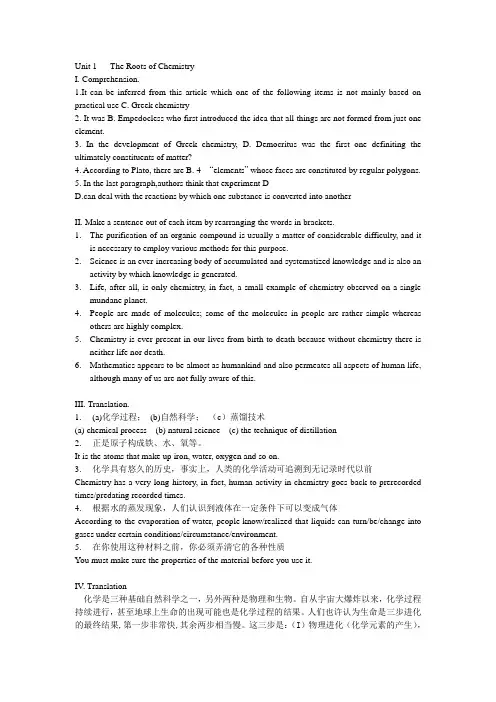
Unit 1 The Roots of ChemistryI. Comprehension.1.It can be inferred from this article which one of the following items is not mainly based on practical use C. Greek chemistry2. It was B. Empedocless who first introduced the idea that all things are not formed from just one element.3. In the development of Greek chemistry, D. Democritus was the first one definiting the ultimately constituents of matter?4. According to Plato, there are B. 4 ―elements‖ whose faces are constituted by regular polygons.5. In the last paragraph,authors think that experiment DD.can deal with the reactions by which one substance is converted into anotherII. Make a sentence out of each item by rearranging the words in brackets.1.The purification of an organic compound is usually a matter of considerable difficulty, and itis necessary to employ various methods for this purpose.2.Science is an ever-increasing body of accumulated and systematized knowledge and is also anactivity by which knowledge is generated.3.Life, after all, is only chemistry, in fact, a small example of chemistry observed on a singlemundane planet.4.People are made of molecules; some of the molecules in people are rather simple whereasothers are highly complex.5.Chemistry is ever present in our lives from birth to death because without chemistry there isneither life nor death.6.Mathematics appears to be almost as humankind and also permeates all aspects of human life,although many of us are not fully aware of this.III. Translation.1.(a)化学过程;(b)自然科学;(c)蒸馏技术(a) chemical process (b) natural science (c) the technique of distillation2.正是原子构成铁、水、氧等。
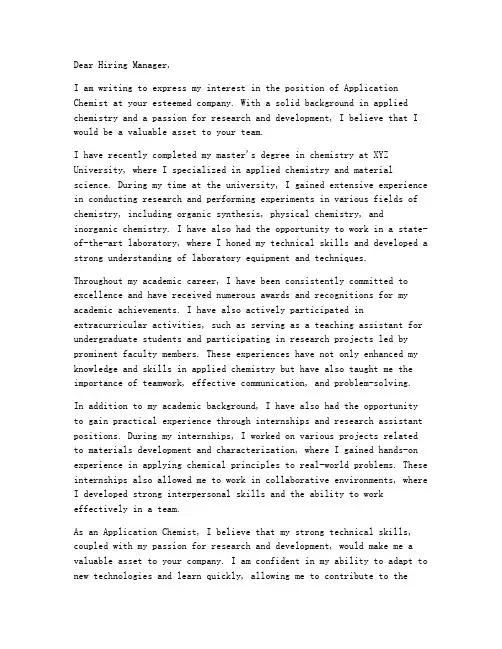
Dear Hiring Manager,I am writing to express my interest in the position of Application Chemist at your esteemed company. With a solid background in applied chemistry and a passion for research and development, I believe that I would be a valuable asset to your team.I have recently completed my master's degree in chemistry at XYZ University, where I specialized in applied chemistry and material science. During my time at the university, I gained extensive experience in conducting research and performing experiments in various fields of chemistry, including organic synthesis, physical chemistry, and inorganic chemistry. I have also had the opportunity to work in a state-of-the-art laboratory, where I honed my technical skills and developed a strong understanding of laboratory equipment and techniques.Throughout my academic career, I have been consistently committed to excellence and have received numerous awards and recognitions for my academic achievements. I have also actively participated in extracurricular activities, such as serving as a teaching assistant for undergraduate students and participating in research projects led by prominent faculty members. These experiences have not only enhanced my knowledge and skills in applied chemistry but have also taught me the importance of teamwork, effective communication, and problem-solving.In addition to my academic background, I have also had the opportunity to gain practical experience through internships and research assistant positions. During my internships, I worked on various projects related to materials development and characterization, where I gained hands-on experience in applying chemical principles to real-world problems. These internships also allowed me to work in collaborative environments, where I developed strong interpersonal skills and the ability to work effectively in a team.As an Application Chemist, I believe that my strong technical skills, coupled with my passion for research and development, would make me a valuable asset to your company. I am confident in my ability to adapt to new technologies and learn quickly, allowing me to contribute to thegrowth and success of your company. I am particularly interested in working on projects that involve material development and characterization, as well as those that have a significant impact on the pharmaceutical, materials, or energy industries.In conclusion, I am excited about the opportunity to join your company and contribute to its continued success. I am confident that my academic background, practical experience, and passion for applied chemistry make me a strong candidate for the Application Chemist position. I have attached my resume for your review, and I would welcome the opportunity to discuss my qualifications further with you. Thank you for considering my application.Sincerely,[Your Name]。
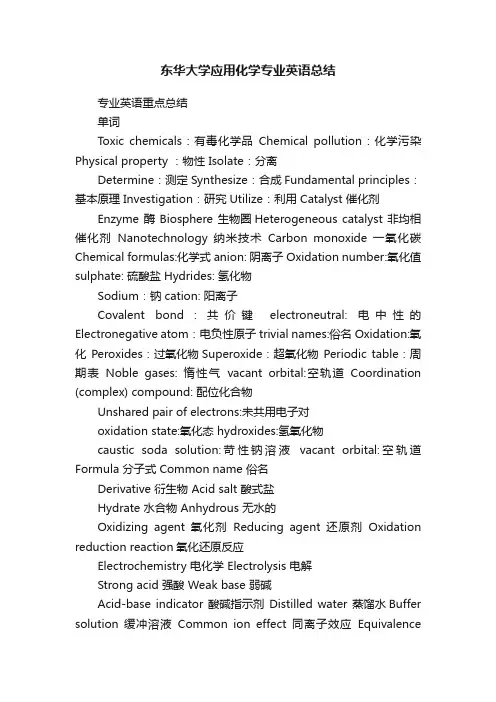
东华大学应用化学专业英语总结专业英语重点总结单词Toxic chemicals:有毒化学品Chemical pollution:化学污染Physical property :物性 Isolate:分离Determine:测定 Synthesize:合成Fundamental principles:基本原理 Investigation:研究Utilize:利用 Catalyst 催化剂Enzyme 酶Biosphere 生物圈Heterogeneous catalyst 非均相催化剂Nanotechnology 纳米技术Carbon monoxide 一氧化碳Chemical formulas:化学式anion: 阴离子 Oxidation number:氧化值sulphate: 硫酸盐 Hydrides: 氢化物Sodium:钠 cation: 阳离子Covalent bond:共价键electroneutral: 电中性的Electronegative atom:电负性原子 trivial names:俗名Oxidation:氧化Peroxides:过氧化物Superoxide:超氧化物Periodic table:周期表Noble gases: 惰性气vacant orbital:空轨道Coordination (complex) compound: 配位化合物Unshared pair of electrons:未共用电子对oxidation state:氧化态 hydroxides:氢氧化物caustic soda solution:苛性钠溶液vacant orbital:空轨道Formula 分子式 Common name 俗名Derivative 衍生物 Acid salt 酸式盐Hydrate 水合物 Anhydrous 无水的Oxidizing agent 氧化剂Reducing agent 还原剂Oxidation reduction reaction氧化还原反应Electrochemistry 电化学 Electrolysis 电解Strong acid 强酸 Weak base 弱碱Acid-base indicator 酸碱指示剂Distilled water 蒸馏水Buffer solution 缓冲溶液Common ion effect 同离子效应Equivalencepoint 等效点 Neutralization 中和Dissociation 离解度 Anhydride 脱水物Periodic law: 元素周期率 periods (rows):周期group (columns):族 protons:质子Valence electrons:价电子 Halogens: 卤素Atomic radius: 原子半径alkaline earths:碱土金属attractive force: 吸引力electronegativity: 电负性electropositive:正电性univalent ion: 一价离子electron shell: 电子层 bonding force 结合力monatomic 单原子的 Neutrons:中子hydrogen bond 氢键conduct electricity 导电Electrically neutral 电中性的Electrostatic 静电的isomerism :异构现象Reversible :可逆的。
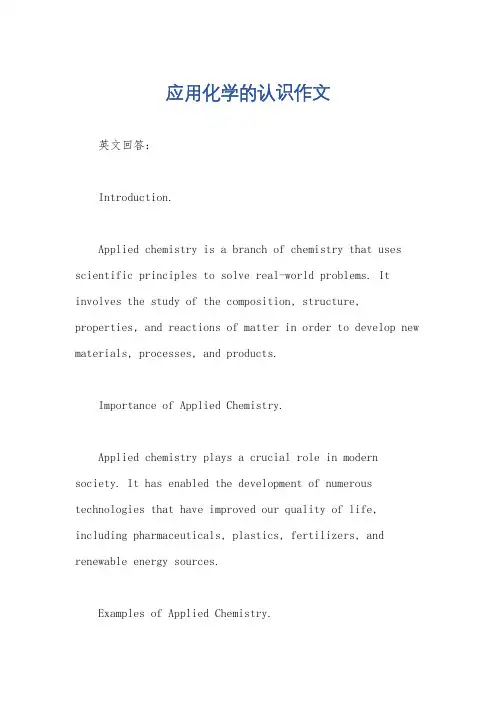
应用化学的认识作文英文回答:Introduction.Applied chemistry is a branch of chemistry that uses scientific principles to solve real-world problems. It involves the study of the composition, structure, properties, and reactions of matter in order to develop new materials, processes, and products.Importance of Applied Chemistry.Applied chemistry plays a crucial role in modern society. It has enabled the development of numerous technologies that have improved our quality of life, including pharmaceuticals, plastics, fertilizers, and renewable energy sources.Examples of Applied Chemistry.Some common examples of applied chemistry include:Pharmaceuticals: The development of drugs to treat diseases and improve health.Materials science: The creation of new materials with advanced properties, such as strength, durability, and conductivity.Environmental chemistry: The study and mitigation of environmental pollution.Food chemistry: The analysis and preservation of food products.Energy chemistry: The development of alternative energy sources and the storage of energy.Applications in Various Industries.Applied chemistry has applications in a wide range ofindustries, including:Healthcare: The development of new drugs, medical devices, and diagnostic tools.Manufacturing: The production of chemicals, plastics, and other materials.Agriculture: The development of fertilizers, pesticides, and crop protection products.Energy: The development of renewable energy sources and the storage of energy.Environmental protection: The study and mitigation of environmental pollution.Career Opportunities in Applied Chemistry.The field of applied chemistry offers a wide range of career opportunities for those with a strong background in the field. These opportunities include:Research & Development: Scientists and engineers develop new materials, processes, and products.Production: Chemists work in manufacturing plants to produce chemicals and other products.Quality Control: Chemists ensure the quality of products by conducting tests and analyses.Environmental Consulting: Chemists provide advice to businesses and organizations on environmental compliance and sustainability.Education: Chemists teach at universities and colleges.Conclusion.Applied chemistry is a versatile and dynamic field that impacts numerous aspects of our daily lives. It offers exciting career opportunities and plays a crucial role in addressing global challenges such as healthcare, energysustainability, and environmental protection.中文回答:导言。
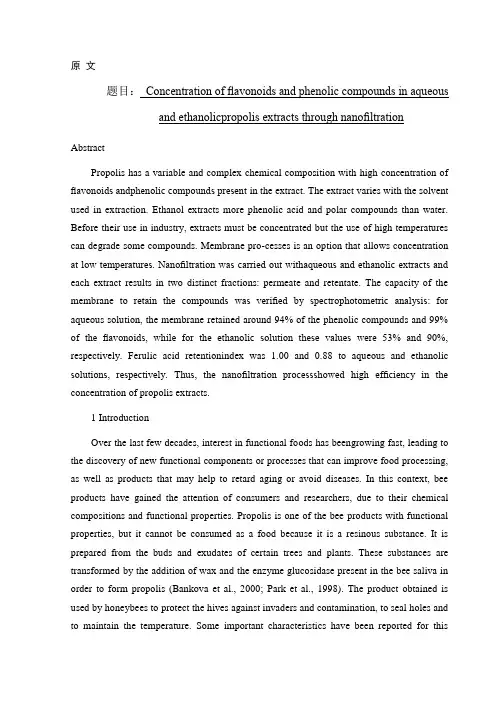
原文题目:Concentration of flavonoids and phenolic compounds in aqueous and ethanolicpropolis extracts through nanofiltrationAbstractPropolis has a variable and complex chemical composition with high concentration of flavonoids andphenolic compounds present in the extract. The extract varies with the solvent used in extraction. Ethanol extracts more phenolic acid and polar compounds than water. Before their use in industry, extracts must be concentrated but the use of high temperatures can degrade some compounds. Membrane pro-cesses is an option that allows concentration at low temperatures. Nanofiltration was carried out withaqueous and ethanolic extracts and each extract results in two distinct fractions: permeate and retentate. The capacity of the membrane to retain the compounds was verified by spectrophotometric analysis: for aqueous solution, the membrane retained around 94% of the phenolic compounds and 99% of the flavonoids, while for the ethanolic solution these values were 53% and 90%, respectively. Ferulic acid retentionindex was 1.00 and 0.88 to aqueous and ethanolic solutions, respectively. Thus, the nanofiltration processshowed high efficiency in the concentration of propolis extracts.1 IntroductionOver the last few decades, interest in functional foods has beengrowing fast, leading to the discovery of new functional components or processes that can improve food processing, as well as products that may help to retard aging or avoid diseases. In this context, bee products have gained the attention of consumers and researchers, due to their chemical compositions and functional properties. Propolis is one of the bee products with functional properties, but it cannot be consumed as a food because it is a resinous substance. It is prepared from the buds and exudates of certain trees and plants. These substances are transformed by the addition of wax and the enzyme glucosidase present in the bee saliva in order to form propolis (Bankova et al., 2000; Park et al., 1998). The product obtained is used by honeybees to protect the hives against invaders and contamination, to seal holes and to maintain the temperature. Some important characteristics have been reported for thissubstance, such as anti-microbial and antioxidant effects, anesthetic properties and others. Due to these characteristics, which can bring health benefits, propolis is considered a functional ingredient and is used in food, beverages, cosmetics and medicine to improve health and prevent diseases (Burdock, 1998; IFIC, 2009). There are over 150 constituents in propolis, including polyphenols, terpenoids, steroids and amino acids. Flavonoids are one of the most important groups and can represent around 50% of the propolis contents,depending on the region where it is collected, since its characterist ics is influenced by plants and weather (Krell, 1996; Park et al., 1998). Kumazawa et al. (2004) tested the antioxidant activity of propolis from various geographic origins and showed different activities for each sample. Other studies indicated that the propolis from Europe and China contained many kinds of flavonoids and phenolic acids, whereas the Brazilian samples had more terpenoids and prenylated derivatives of p-cumaric acid (Bankova et al., 2000). Finally, each combination of compounds in the propolis of acertain origin can represent specific characteristics in the final product.The most common propolis extracting process uses ethanol as the solvent. However, this has some disadvantages such as the strong residual flavor, adverse reactions and intolerance to alcohol of some people (Konishi et al., 2004). Researchers and industry are interested in producing a new type of extract with the same compounds extracted by the ethanolic method, but without the disadvantages. Water has been tested as the solvent, but resulted in a product containing less extracted compounds (Park et al., 1998). Konishi et al. (2004) tested water with a combination of some tensoactive compounds to replace part of the alcohol used in propolis extraction and all the tests were efficient in extracting it, and the product showed good anti-microbial activity.Depending on the application, the solvent in propolis extracts must be reduced or eliminated. The processes that are used today, as lyophilization, vacuum distillation and evaporation, have some disadvantages like the use of high temperatures and high energy consumption. Lyophilization requires large amounts of energy, since the sample needs to be maintained at À20 °C for at least 24 h, and energy is also required for the sublimation of the solvent used during preparation of the extract. Moreover, the method often requires a previous stage of concentration, maintaining the product at 70 °C until part of the solvent is evaporated.Vacuum distillation requires great amounts of energy to generate the vacuum, and can lead to loss of compounds of low molecular weight, which can be removed together with the solvent evaporated in the system. Evaporation maintains the extract underheating at 70 °C, until all the solvent is removed. This process, in addition to the high demand for energy, can degrade the flavonoid and phenolic compounds in propolis, due to the temperature used. However, it is the process that gives greater ease of implementation in companies due to low cost on the equipment required compared with the previous cases. The use of membrane concentration processes has been growing due to certain advantages, such as: low temperatures, absence of phase transition and low energy consumption (Matta et al., 2004). This procedure is based on the principle of selective permeation of the solute molecules through semi-permeable, polymeric or inorganic membranes. The driving force for mass transfer across the membrane in most membrane processes, such as a microfiltration, ultrafiltration, nanofiltratio n and reverse osmosis is mechanical pressure (Maroulis and Saravacos, 2003). Nanofiltration is a unit operation that permits many applications, such as solvent recovery from filtered oil, exchange of solvents in the chemical industry (Geens et al., 2006), co ncentration and purification of ethanolic extracts of xantophylls, which is important in both the pharmaceutical and food industries (Tsui and Cheryan, 2007) and in wine concentration (Banvolgyi et al., 2006), as well as in juice concentration (Vincze et al., 2006) in the food industry.The objective of this study was to investigate the membrane concentration of propolis extracts using water and ethanol as the solvents, exclusively, verifying the quality of the concentrated products in terms of the retention of flavonoids and phenolic compounds during processing. The process was evaluated according to the permeate flux, influence of temperature and pressure and concentration factor. The results obtained for each solution were compared to verify the viability of developing a new propolis product, based on water as the solvent.2. Materials and methods2.1. PropolisRaw propolis was obtained from Apis mellifera beehives in the State of São Paulo, Brazil, and was acquired in a single batch, in order to minimize the variability associated with the vegetation used for its production and the weather conditions. It was stored under第 3 页refrigeration (4 °C) until use in the preparation of extracts.The propolis produced in this region is characterized as group 12 (Brazil has 12 different groups of propolis, with distinct characteristics) and presents a great amount of soluble substances, antimicrobial activity against Staphylococcus aureus and Streptococcus mutans and greater anti-inflammatory activity than samples from other parts of the country, which can be associated with the higher concentrations of flavonoids and phenolic compounds found in this group (Park et al., 2002).The ethanolic propolis solution was prepared from crude propolis previously comminuted in a bench blender with a 500 W motor, homogenized, weighed on a semi-analytical balance and mixed with 80% ethanol. The mixture was kept at room temperature for 7 days and manually stirred once a day. After this period, the sample was centrifuged (Beckman –Allegra 25-R, Beckman Coulter, German) at 8800 g for 20 min. The supernatant was filtered and refrigerated for 3 h at 4 °C and then filtered again for wax removal. Finally, the esulting extract was stored at room temperature in the dark.Preparation of the aqueous solutions followed the same procedures, using deionized water. Each solution was prepared in a proportion of 20% propolis and 80% solvent. Both extracts were evaluated with respect to their flavonoid and phenolic compounds contents, to be compared with the concentrated products.2.2. Determination of total flavonoidsThe total flavonoid content of the propolis solutions was determined by the aluminum complexation method (Marcucci et al., 1998). In this procedure, the extracted solutions were diluted in the proportion of 1:10 (0.5 mL) and mixed with 0.1 mL of 10% aluminum nitrate, 0.1 mL of 1 mol/L potassium acetate and 4.3 mL of 80% ethyl alcohol. The samples were kept at room temperature for 40 min and the absorbance read at 415 nm. Quercetin was used as the standard to produce the calibration curve. The mean of three readings was used and the total flavonoid content expressed in mg of quercetin equivalents (mg/g).2.3. Determination of the phenolic compoundsThe polyphenols in the propolis solutions were determined by the Folin–Ciocalteau colorimetric method (Kumazawa et al., 2004). According to this procedure, the extracted solution was previously diluted in the proportion of 1:10 (0.5 mL) and then mixed with 0.5 mL of the Folin–Ciocalteau reagent and 0.5 mL of 10% Na2CO3. The absorbance was readat 760 nm after 1 h of incubation at room temperature. Gallic acid was used as the standard to produce the calibration curve. The mean of three readings was used and the total phenolic content expressed in mg of gallic acid equivalents (mg/g).2.4. HPLC determinationThe compounds present in the initial extract, permeate and concentrated products, were determined by HPLC as described by Parket al. (1998). Three hundred microliters of each solution were injected into a liquid chromatograph (Shimadzu, Tokyo, Japan) connected to a diode-array detector at 260 nm. The mobile phase was water/acetic acid (19:1, v/v) (solvent A) and methanol (solvent B), with a constant flow rate of 1 mL/min. The gradient started at30% solvent B, passing to 60% at 45 min, 75% at 85 min, 90% at 95 min and back to 30% at 105 min. The column was maintained at a constant temperature of 30 °C and the chromatograms processed using the computer software Chromatography Workstation (Shimatzu Corporation, Tokyo, Japan). The initial and concentrated samples were diluted in 1.5 mL of distilled water and the permeate sample was injected without dilution. The following authentic standards of phenolic acids and flavonoids (Extrasynthese, Genay, France) were examined: q-cumaric acid, ferulic acid, cinnamicacid, gallic acid, quercetin, kaempferol, kaempferide, apigenin, isorhamnetin, rhamnetin, sakuranetin, isosakuranetin, hesperidin, hesperetin, pinocembrin, chrysin, acacetin, galangin, myricetin, tectochrysin and artepillin C, as they correspond to the most usual compounds present in propolis.2.5. Membrane concentrationIn this study, the propolis extracts were concentrated using a tangential filtration system on a pilot scale, with a nanofiltration membrane as seen in the schematic diagram shown in Fig. 1. The experiments were performed on pilot equipment that permits the batch circulation mode, which means that both permeate and concentrate could be carried back to the feed tank. The permeate was totally removed just in a single experiment, where it was necessaryto obtain the concentrated product of the process. The nanofiltra tion module is equipped with a NF90 membrane (Osmonics, Minnetonka, USA) which is composed of polyamide and polysulphone, with 0.6 m2 of filtration ar ea and 98% rejection of MgSO4 ina test performed by manufacturing with a spiral module at 20 °C and 6.0 bar. Approximately5.0 L of each solution permeated through the membrane over 30 min, this being the time necessary to complete the concentration in an open system, which means that the permeate第 5 页was removed from the process. In the trials the permeate was removed and the retentate re-circulated until a concentration factor of around four. The concentration factor is calculated according to Eq. (1):Fig. 1. Schematic diagram of the nanofiltration unit where Vf is the total volume used in the feed, Vc is the volume collected in the concentrate fraction and Fc is the concentration factor. Other experiments were carried out at different temperatures (20–45 °C) and pressures (2.0–5.0 bar), in order to evaluate the influence of these parameters on the permeate flux and the concentrated product quality. In these experiments, both the permeate and retentate were maintained under re-circulation in closed sy stems. The permeate flux was calculated according to the following equation: J=Vp/t*Ap (2)where Vp is the permeate volume collected during the time intervalt and Ap is the membrane surface area of permeation. The quality of the filtration process was measured according to the quantity of flavonoids and phenolic compounds present in permeate, evaluated as described in Sections 2.2–2.4, and the efficiency was measured according to the flux permeate rate and retention index. This index m easures the relation between the amounts of the compound of interest in permeate and in the concentrated solution, which demonstrates the ability of the membrane to retain this compound under the experimentalconditions. The index is calculated according to Eq. (3), in which R is the retention index, Cp is the concentration of the compound of interest in the permeate, and Cr is the concentration of the same compound in the retentate:R=1-Cp/Cr (3)It is important to know the rate of fouling that occurs in the membrane process, and one way of measuring this is to compare the permeate flux of the solution under study with the permeate flux when water is used as feed solution, under different pressures. Usually a variation in system pressure will cause a change directly proportional to the permeate flux. The fouling influence was measured by comparison of the permeate flux of the aqueous propolis extract with the flux of distilled water only, increasing the pressure from 1.0 to 5.0 bar.3. Results and discussionThe membrane process was carried out with the aqueous and ethanolic solutions in a closed system, in which the retentate and permeate streams being conducted back and mixed in a feed tank isolated from the environment, to evaluate the variation in pe rmeate flux with time. The temperature was maintained at 20 °C and the pressure at 5.0 bar. The results are shown in Fig. 2.After stabilization of the process, the permeate flux began to decrease, after around 15 min of processing. The rate of decrease was higher for the alcoholic extract than for the第7 页aqueous extract, evidencing a greater rate of fouling with the alcohol solution. After 20 min of processing, the permeate flux tended to stabilize, that is, concentration polarization already occurred and fouling did not increase with time. The permeate flux in the stable region was about 12.0 L/h m2and 25.0 L/h m2for alcoholic and aqueous solutions, respectively. The difference between the permeate flux of these solutions can be explained by their different compositions: the alcohol extract contains more compounds of low molecular weight, thus its concentration is more difficult to achieve, and this reduces the flux rate. Some of these compounds form a kind of wax which can cause more fouling in membrane.Tsui an d Cheryan (2007) used nanofiltration to purify alcoholic corn extracts in the production of xanthophylls, and obtained a permeate flux of around 10.0 L/h m2when working at 27 bar and 50 °C. Hossain (2003) studied the membrane concentration of anthocyanins f rom blackcurrant pomace extracts using ultrafiltration, obtaining a maximum permeate flux of 17.3 L/h m2 at 1.4 bar and 18 °C. Using nanofiltration a permeate flux of 20 L/h m2 was obtained at 20 bar and 50 °C in the concentration of red wine (Banvolgyi et al., 2006). The red wine concentration process is important since it can be considered a similar process to the concentration of alcoholic propolis, considering that they have similar compounds in solution and use alcohol as the solvent. The similarities between the processes allow a comparison between results. Low pressures (around 6 bar) were used in the propolis concentration process, when compared to other processes cited in the literature, but even so the values obtained for the permeate flux were similar to those obtained in the other processes. Therefore this process can be assumed to be viable, mainly because of the reduced energy requirements necessary to generate the lower pressure.The pressure adopted was not characteristic of nanofiltration processes,but was sufficient to carry out this concentration procedure.Fig. 3 shows the difference between the curve of the permeate flux for the aqueous propolis extract and the curve of the permeate flux for distilled water to measure the degree of fouling in the process with the aqueous propolis solution.The difference between the permeate fluxes of water and the propolis solution shows the amount of fouling in the process, under the same conditions of temperature and pressure. This parameter increased, reaching 32% at 5.0 bar. The procedure also provided information on how the flux wasaffected by a pressure variation, showing that the flux changed linearly with the pressure in the region studied. In this pressure range of operation, the concentrated products did not present significant variation among the experiments.By increasing the temperature from 20 to 45 °C and maintaining the pressure at 6.0 bar it was possible to determine the relation ship between the temperature and the permeability of the membrane. Permeate flux increased proportionally, by around 8% per degree of temperature, as shown in Fig. 4. This result may be attributed to the effect of temperature on the viscosity of the solution. Also, the composition of the concentrated products obtained at different temperatures showed no significant difference among them, thus, a higher flux can be obtained by increasing the temperature.The initial solutions, permeates and concentrates obtained by nanofiltration in open system were all subjected to a spectrophotometric analysis as described in Sections 2.2 and 2.3. The results for the aqueous solution indicated that this permeate only contained small amounts of phenolic compounds and flavonoids, while the permeate from the ethanolic solution showed greater amounts, mostly of low molar weight phenolic compounds. Considering the losses in the compounds of interest in the resulting permeate, as compared to the initial solution, it can be seen that the aqueous solution of propolis retained almost 99% of the flavonoi ds and 84% of the phenolic compounds. However, for the ethanolic第9 页solution, these values were 90% and 53% for the flavonoids and phenolic compounds, respectively,as shown in Table 1. The lower retention obtained can be explained by the occurrence of plasticization in the case of ethanolic solution. This phenomenon can cause a membrane swelling or dilation, which in turn can increase the membrane diffusivity and solubility, causing loss of compounds in process.The results for the determination of flavonoids an d phenolic compounds carried out by spectrophotometric methods were verified by HPLC analysis, as described in Section 2.4. The substances were identified by a comparison of their retention times and ultraviolet spectra with those of standards in the literature. Chromato grams were obtained from the initial aqueous extract, and from the concentrated and permeated products, which are represented in Fig. 5a–c, where the numbers 1–3 indicate the peaks identified in the HPLC analysis.Table 2 shows the results of the quantitative analysis for all samples from the aqueous propolis solution. Comparing these data, it can be seen that there were no losses of ferulic acid to the permeate and only 20% of the caffeic acid present in the initial solution was lost to the permeate, this compound thus being the most abundant in the concentrated extract, of the compounds identified. All the aqueous solutions showed peaks located in the region that第 11 页represents a retention time of up to 20 min. This occurred since the water, being a polar material, only extracts polar compounds. The last peak identified in the permeated solution, probably does not represent an isolated compound but interference in the system, since this compound was not present in the other chromatograms. Ferulic acid was not identified in the permeated solution, indicating that no losses to the permeate occurred. The other peaks in the chromatograms represented compounds that could not be identified according to the standards in the literature. The permeated solution showed a small amount of compounds in low con centration, allowing to verify the efficacy of the membraneconcentration process.Park et al. (1998) analyzed an aqueous propolis solution prepared in the laboratory, using HPLC, and obtained similar results to those presented in Fig. 5a, reporting peaks with low retention times that represent polar substances, and identifying the compounds quercetin and pinocembrin. In their experiment, the proportions of water and alcohol in the solvents for propolis extraction were varied. Initial solutions contained 0–90% of alcohol, through which it was demonstrated that increasing the proportion of alcohol in the solution also increased the amount ofextracted flavonoids and phenolic compounds in the propolis.The chromatograms obtained for the ethanolic solutions are presented in Fig. 5d–f. It was possible to identify peaks in the ethanolic solution throughout the process. Compounds with a retention time greater than 20 min are apolar and were extracted by ethanol, this being an advantage of the use of this solvent as compared to water, which does not extract apolars. On analyzing the chromatogram it can be seen that a considerable amount of cumaric acid was lost to the permeate (peak number 2 in Fig. 5f). This acid belongs to the phenolic acid class and has a low molar weight, which could explain the low retention capacity of the membrane for this compound. The results of the spectrophotometric analysis shown in Table 1 indicate a loss of phenolic compounds to the permeate, accounting for the cumaric acid and other compounds not being identified by the HPLC method. Using the data given in Tables 2 and 3 the retention index could be calculated from Eq. (2). These results can be observed in Table 4. The retention indexes verified t hat the membrane process retained the compounds of interest better when using aqueous solutions, since this resulted in smaller losses of the compounds studied to the permeate, as compared to such losses when working with the alcoholic solution. Cumaric acid was an exception, since only 56% of this compound was not lost to permeate. Despite the loss of compounds, the values obtained represent a high retention index and verify that the nanofiltration process is appropriate for propolis extracts.During their study on the concentration of red wine by nanofiltration, Banvolgyi et al. (2006) obtained a retention index of 88% for total acids, 50% for free sulfuric acids and 93% for the total extracts. Tsui and Cheryan (2007), working with the purification of xantophy lls by nanofiltration obtained a retention index of 90% for total solids, 88% for proteins and 98% for xanthophylls, the major compound of their study.In the present study, the values obtained for the retention indexes were very similar tothose cited in the literature for similar processes..4 ConclusionsThe results showed that nanofiltration can be considered as a good alternative for concentrating propolis extracts, since the membrane retained most of the flavonoids and phenolic compounds, which are of major importance to propolis quality. Particularly in the case of the aqueous extract, it could be considered that there was no loss of compounds to the permeate solution, since almost 100% of the major compounds were retained. In the experiments with alcoholic propolis, the losses were considerable but this is a consequence of the higher amount of compounds extracted by alcohol. However, the method can be used for alcoholic solution since almost 90% of the flavonoids were retained. Application of this technology could increase the use of propolis in many industrial applications, it being feasible to use the aqueous extract in new research projects and in the development of new products with functional properties. Furthermore, this process allows removal of the solvent from the extract, reducing the disadvantages associated with using alcoholic extractions. It should be noted that compared with other concentration methods, in the membrane process the product is not submitted to high temperatures and there is no change in the physical state of the solvent, which means that the functional properties of the compounds of interest are preserved and the process as a whole is energy saving.第13 页译文题目:黄酮类化合物和酚类化合物在水中和乙醇蜂胶中通过纳滤膜的提取率关键词:蜂胶膜浓度黄酮类化合物酚类化合物纳滤摘要:蜂胶具有可变的、复杂的化学成分,且蜂胶中黄酮类化合物的浓度较高,酚类化合物存在于蜂胶萃取物。
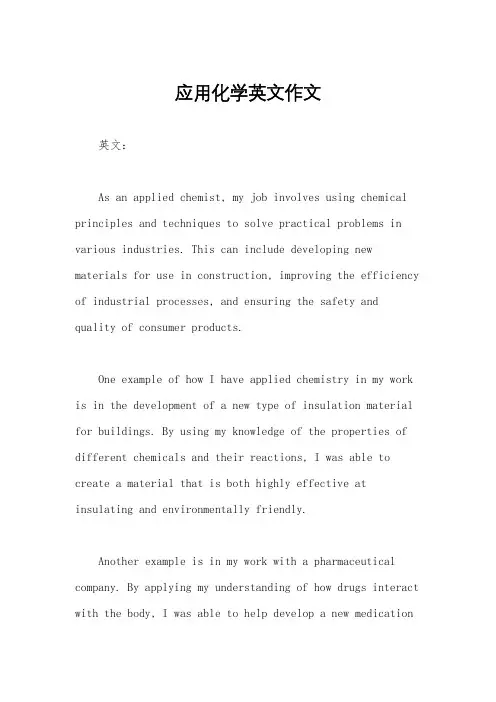
应用化学英文作文英文:As an applied chemist, my job involves using chemical principles and techniques to solve practical problems in various industries. This can include developing new materials for use in construction, improving the efficiency of industrial processes, and ensuring the safety andquality of consumer products.One example of how I have applied chemistry in my work is in the development of a new type of insulation material for buildings. By using my knowledge of the properties of different chemicals and their reactions, I was able to create a material that is both highly effective at insulating and environmentally friendly.Another example is in my work with a pharmaceutical company. By applying my understanding of how drugs interact with the body, I was able to help develop a new medicationthat is more effective and has fewer side effects than previous treatments.Overall, being an applied chemist requires a strong foundation in chemical principles, as well as the ability to think creatively and apply that knowledge to real-world problems.中文:作为一名应用化学家,我的工作涉及使用化学原理和技术来解决各种行业中的实际问题。
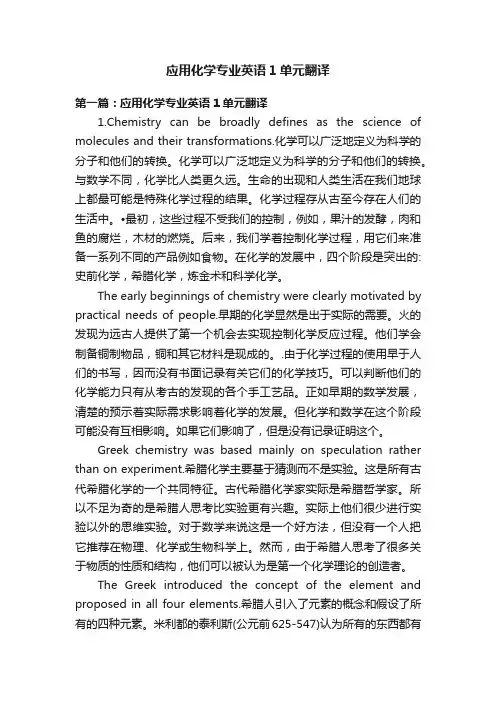
应用化学专业英语1单元翻译第一篇:应用化学专业英语1单元翻译1.Chemistry can be broadly defines as the science of molecules and their transformations.化学可以广泛地定义为科学的分子和他们的转换。
化学可以广泛地定义为科学的分子和他们的转换。
与数学不同,化学比人类更久远。
生命的出现和人类生活在我们地球上都最可能是特殊化学过程的结果。
化学过程存从古至今存在人们的生活中。
•最初,这些过程不受我们的控制,例如,果汁的发酵,肉和鱼的腐烂,木材的燃烧。
后来,我们学着控制化学过程,用它们来准备一系列不同的产品例如食物。
在化学的发展中,四个阶段是突出的:史前化学,希腊化学,炼金术和科学化学。
The early beginnings of chemistry were clearly motivated by practical needs of people.早期的化学显然是出于实际的需要。
火的发现为远古人提供了第一个机会去实现控制化学反应过程。
他们学会制备铜制物品,铜和其它材料是现成的。
.由于化学过程的使用早于人们的书写,因而没有书面记录有关它们的化学技巧。
可以判断他们的化学能力只有从考古的发现的各个手工艺品。
正如早期的数学发展,清楚的预示着实际需求影响着化学的发展。
但化学和数学在这个阶段可能没有互相影响。
如果它们影响了,但是没有记录证明这个。
Greek chemistry was based mainly on speculation rather than on experiment.希腊化学主要基于猜测而不是实验。
这是所有古代希腊化学的一个共同特征。
古代希腊化学家实际是希腊哲学家。
所以不足为奇的是希腊人思考比实验更有兴趣。
实际上他们很少进行实验以外的思维实验。
对于数学来说这是一个好方法,但没有一个人把它推荐在物理、化学或生物科学上。
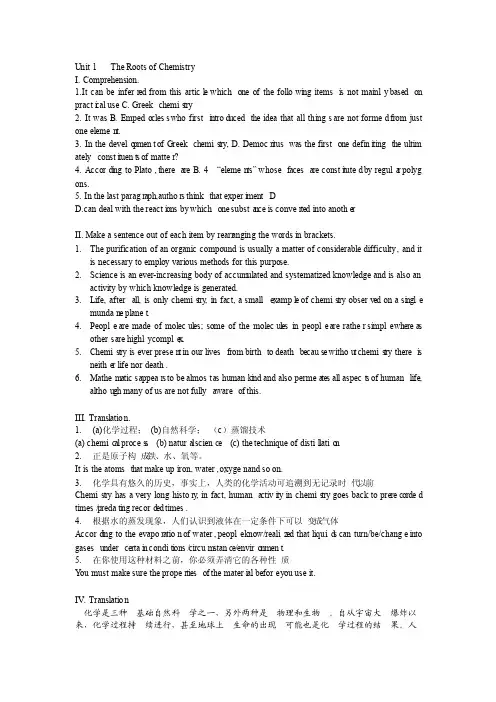
Unit 1 The Rootsof Chemis tryI. Compre hensi on.1.It can be inferred from this articl e whichone of the followi ng itemsi s not mainly basedon practi c al use C. Greekchemis try2. It was B. Empedo cless who firsti ntrod ucedthe idea that all things are not formed from just one elemen t.3. In the develo pment of Greekchemis t ry, D. Democri tus was the first one defini tingthe ultimatelyconsti tuent s of matter?4. Accord i ng to Plato, thereare B. 4 ―elemen ts‖ whosefacesare consti tuted by regula r polygons.5. In the last paragraph,authors thinkthat experi ment DD.can deal with the reacti ons by whichone substa n ce is converted into anothe rII. Make a senten ce out of each item by rearra nging the wordsin bracke ts.1.The purifi catio n of an organi c compou nd is usuall y a matter of consid erabl e diffic ulty, and itis necess ary to employ variou s method s for this purpos e.2.Scienc e is an ever-increa singbody of accumu lated and system atize d knowle dge and is also anactivi ty by whichknowle dge is genera ted.3.Life, afterall, is only chemis try, in fact, a smallexampl e of chemis try observ ed on a si nglemundan e planet.4.People are made of molecul es; some of the molecul es in people are rather simple wherea sothers are highly comple x.5.Chemist ry is ever presen t in our livesfrom birthto deathbecause withou t chemis t ry therei sneithe r life nor death.6.Mathem atics appears to be almost as humanki nd and also permea tes all aspect s of humanlife,althou gh many of us are not fullyawareof this.III. Transl ation.1.(a)化学过程;(b)自然科学;(c)蒸馏技术(a) chemic al proces s (b) natura l science (c) the techni que of distil latio n2.正是原子构成铁、水、氧等。
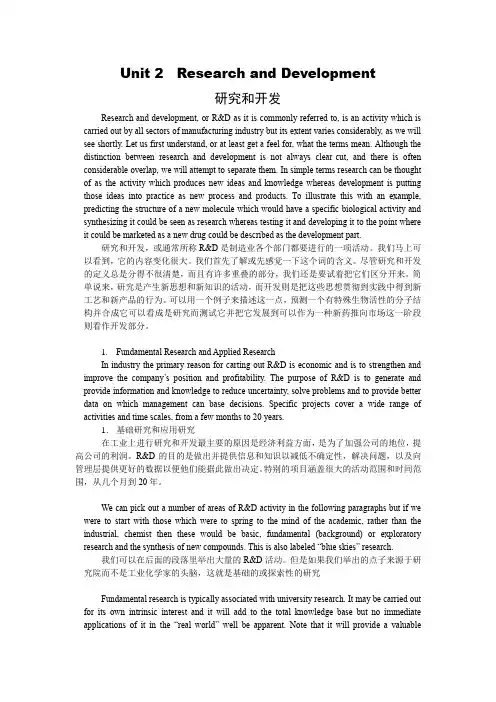
Unit 2 Research and Development研究和开发Research and development, or R&D as it is commonly referred to, is an activity which is carried out by all sectors of manufacturing industry but its extent varies considerably, as we will see shortly. Let us first understand, or at least get a feel for, what the terms mean. Although the distinction between research and development is not always clear-cut, and there is often considerable overlap, we will attempt to separate them. In simple terms research can be thought of as the activity which produces new ideas and knowledge whereas development is putting those ideas into practice as new process and products. To illustrate this with an example, predicting the structure of a new molecule which would have a specific biological activity and synthesizing it could be seen as research whereas testing it and developing it to the point where it could be marketed as a new drug could be described as the development part.研究和开发,或通常所称R&D是制造业各个部门都要进行的一项活动。
Unit 1 Scientific Paper and LiteratureLesson 1Writing a Scientific Paper这一章节是写科学论文一个总的指导。
包括对于文章长度要求,数字和图标的制备,还有向不同杂志和出版商提交论文的说明指导方针。
对于美国化学学会杂志和特殊的出版物,请阅读出现在每年第一期和全球网上对于作者的指南,注释,公告和说明。
对于美国化学学会的书目,请查阅一些像《如何为ACS准备你的底稿》,《作者须知》这样的小册子,这些资料可以从书籍部或者在相同地址的全球网页上得到。
Introduction to Science Paper一篇研究论文是学术交流的书面形式,它可以用来传播有用的信息并且可以和别人分享有用的学术见解。
大多数的研究论文是用于杂志出版或者作为个人领域的会议记录。
出版史作为传播见解和专业认知与提高最快捷的方法。
如果你对学术文章的特点和形式有着清晰的认识,那么你的论文可以更容易的在目标杂志上发表或者被国际会议所采纳。
Features of Academic Papers 学术论文的特色学术论文的第一个特色就是内容。
它只不过是你做的部分研究客观并且准确的记录,要么是关于人文、社会、科学、自然科学或者应用科学。
它不能用来教授或者提供一般背景。
论文的第二个特征就是这一目的的写作方式。
你的论文必须包含三种要素:严格的逻辑结构,清晰和简洁的语言,还有就是你论文要提交的杂志所规定的特定写作形式。
第三,实际上是第二条的一部分,就是文章所用资源的引证系统。
在文章过程的每一步里,你必须对你从资源查阅到的想法、事实、观点进行充分考虑。
学术论文中的特征中最方便的地方之一是学术论文被清晰的分成几个部分。
这一点对你很有帮助,因为你每次只需考虑一个部分。
当你撰写其中一个部分时你总能总揽全文。
尽管人文科学和社会科学没有明显的界限,但是他们遵循科学论文的一般要求。
Getting Started尽管学术论文不想食谱配方或者实验流程一样有一套固定的写作规矩,但是一些指导方针也是很有帮助的。
应用化学专业英语翻译(新版)Unit10 Nomenclature of Hydrocarbons碳氢化合物的命名Alkanes烷烃理想的,每一种化合物都应该由一个明确描述它的结构的名称,并且通过这一名称能够画出它的结构式。
为了这一目的,全世界的化学家接受了世界纯粹与应用化学会(IUPAC)建立的一系列规则。
这个系统就是IUPAC系统,或称为日内瓦系统,因为IUPAC的第一次会议是在瑞士日内瓦召开的。
不含支链的烷烃的IUPAC命名包括两部分(1)表明链中碳原子数目的前缀;(2)后缀-ane,表明化合物是烷烃。
用于表示1至20个碳原子的前缀见表表中前4个前缀是由IUPAC选择的,因为它们早已在有机化学中确定了。
实际上,它们甚至早在它们成为规则之下的结构理论的暗示之前,它们的地位就确定了。
例如,在丁酸中出现的前缀but-,一种表示在白脱脂中存在的四个碳原子的化合物(拉丁语butyrum白脱(黄油))。
表示5个或更多碳原子的词根来源于希腊或拉丁词根。
含取代基的烷烃的IUPAC名称由母体名称和取代基名称组成,母体名称代表化合物的最长碳链,取代基名称代表连接在主链上的基团。
来源于烷烃的取代基称为烷基。
字母R-被广泛用来表示烷烃的存在.烷烃的命名是去掉原烷基名称中的-ane加上后缀-yl。
例如,烷基CH3CH2-称为乙基。
CH3-CH3乙烷(原碳氢化合物)CH3CH2-乙基(一个烷基)下面是IUPAC的烷烃命名规则:1. 饱和碳氢化合物称为烷烃。
2. 对有支链的碳氢化合物,最长的碳链作为主链,IUPAC命名按此主链命名。
3. 连接在主链上的基团称为取代基。
每一取代基有一名称和一数字.这一数字表示取代基连接在主链上的碳原子的位置。
4. 如果有多于一个的相同取代基,要给出表示支链位置的每个数字。
而且,表示支链数目的数字由前缀di-,tri-,tetra-,penta-等表示。
5. 如果有一个取代基,主链碳原子编号从靠近支链的一端开始,使支链位号最小。
1. Applied Chemistry 应用化学2. Reaction Mechanisms 反应机理3. Homogeneous Catalysis 均相催化剂4. Heterogeneous Catalysis 非均相催化剂5. The pH Scales pH值6. Proton-Transfer Reactions 质子转移反应7. Conjugate Acid-Base Pairs 共轭酸碱对8. Relative Strength of Acids and Bases 酸碱的相对强度9. Lewis Acids and Bases 路易斯酸碱10. Hydrolysis of Metal Ions 金属离子的水解11. Buffer Solutions 缓冲溶液12. The Common-Ion Effects 同离子效应13. Buffer Capacity 缓冲容量14. Formation of Complex Ions 配离子的形成15. Solubility 溶解度16. The Solubility-Product Constant K sp溶度积常数17. Precipitation and separation of Ions 离子的沉淀与分离18. Selective Precipitation of Ions 离子的选择沉淀19. Oxidation-Reduction Reactions 氧化还原反应20. Half-Reaction 半反应21. Galvani Cell 原电池22. V oltaic Cell 伏特电池23. Cell EMF 电池电动势24. Energies of Orbital 轨道能量25. The Pauli Exclusion Principle 泡林不相容原理26. Electron Configurations 电子构型27. The Periodic Table 周期表28. Friedel-Crafts reaction 傅列德尔-克拉夫茨反应29. carboxylic acid derivative 羧酸衍生物30.Isotopes, Atomic Numbers, and Mass Numbers 同位素,原子数,质量数31. Periodic Properties of the Elements 元素的周期律32. Radius of Atoms 原子半径33. Ionization Energy 电离能34. Electronegativity 电负性35. Effective Nuclear Charge 有效核电荷36. Electron Affinities 亲电性37. Valence Bond Theory 价键理论38. Covalence Bond 共价键39. Orbital Overlap 轨道重叠40. Hybrid Orbital 杂化轨道41. The VSEPR Model 价层电子对互斥理论42. Molecular Geometries 分子空间构型43. Molecular Orbital 分子轨道44. Diatomic Molecules 双原子分子45. Bond Length 键长46. Bond Order 键级47. Bond Angles 键角48. Bond Enthalpies 键能49. Bond Polarity 键矩50. Dipole Moments 偶极矩51. Polarity Molecules 极性分子52. Polyatomic Molecules 多原子分子53. Crystal Structure 晶体结构54. Non-Crystal 非晶体55. Close Packing of Spheres 球密堆积56. Metallic Solids 金属晶体57. Metallic Bond 金属键58. Kekule structure 凯库勒结构式59. Ionic Solids 离子晶体60. Ion-Dipole Forces 离子偶极力61. Molecular Forces 分子间力62. Intermolecular Forces 分子间作用力63. Hydrogen Bonding 氢键64. Covalent-Network Solids 原子晶体65. Compounds 化合物66. The Nomenclature, Composition and Structure of Complexes 配合物的命名,组成和结构67. Charges, Coordination Numbers, and Geometries 电荷数、配位数、及几何构型68. Isomerism 异构现象69. Structural Isomerism 结构异构70. Stereoisomerism 立体异构71.Electron Configurations in Octahedral Complexes 八面体构型配合物的电子分布72. Tetrahedral and Square-planar Complexes 四面体和平面四边形配合物73. General Characteristics 共性74. s-Block Elements s区元素75. Alkali Metals 碱金属76. Alkaline Earth Metals 碱土金属77. Peroxides and Superoxides 过氧化物和超氧化物78. Hydroxides 氢氧化物79. p-Block Elements p区元素80.Boron Group (Boron, Aluminium, Gallium, Indium, Thallium) 硼族(硼,铝,镓,铟,铊)81. Carbon Group (Carbon, Silicon, Germanium, Tin, Lead) 碳族(碳,硅,锗,锡,铅)82. Carbonic Acid, Carbonates and Carbides 碳酸,碳酸盐,碳化物83. Nitrogen Group (Phosphorus, Arsenic, Antimony, and Bismuth) 氮族(磷,砷,锑,铋)84. Oxygen Group (Oxygen, Sulfur, Selenium, and Tellurium) 氧族元素(氧,硫,硒,碲)85. Sulfides 硫化物86. Halogens (Fluorine, Chlorine, Bromine, Iodine) 卤素(氟,氯,溴,碘)87. Halides, Chloride 卤化物,氯化物88. The Noble Gases 稀有气体89. Noble-Gas Compounds 稀有气体化合物90. Transition Metals 过渡金属91. f-Block Elements f区元素92. analytical chemistry 分析化学93. qualitative analysis 定性分析94. quantitative analysis 定量分析95. chemical analysis 化学分析96. instrumental analysis 仪器分析97. titrimetry 滴定分析98. gravimetric analysis 重量分析法99. regent 试剂100. chromatographic analysis 色谱分析101. electrochemical analysis 电化学分析102. on-line analysis 在线分析103. macro analysis 常量分析104. characteristic 表征105. micro analysis 微量分析106. deformation analysis 形态分析107. semimicro analysis 半微量分析108. systematical error 系统误差109. routine analysis 常规分析110. random error 偶然误差111. gross error 过失误差112. normal distribution 正态分布113. deviation偏差114. precision精密度115. relative standard deviation相对标准偏差(RSD)116. coefficient variation变异系数(CV)117.confidence level置信水平118. confidence interval置信区间119. significant test显著性检验120. significant figure有效数字121. standard solution标准溶液122. titration滴定123. stoichiometric point化学计量点124. titration error滴定误差125. primary standard基准物质126. amount of substance 物质的量127. chemical equilibrium化学平衡128. general equation for a chemical reaction化学反应的通式129. proton theory of acid-base酸碱质子理论130. acid-base titration 酸碱滴定法131. dissociation constant解离常数132. conjugate acid-base pair 共轭酸碱对133. hydronium ion水合氢离子134. electrolyte 电解质135. ion-product constant of water水的离子积136. ionization电离137. proton condition质子平衡138. buffer solution缓冲溶液139. acid-base indicator 酸碱指示剂140. coordination compound配位化合物141. center ion中心离子142. cumulative stability constant累积稳定常数143. alpha coefficient酸效应系数144. overall stability constant 总稳定常数145. ligand 配位体146. side reaction coefficient副反应系数147. coordination atom配位原子148. coordination number 配位数149. lone pair electron孤对电子150. metal indicator 金属指示剂151. masking掩蔽152. demasking解蔽153. oxidation氧化154. catalyst催化剂155. reduction还原156. electrode potential电极电势157. redox couple 氧化还原电对158. redox indicator氧化还原指示159. oxygen consuming耗氧量(OC)160. chemical oxygen demanded 化学需氧量(COD) 161. dissolved oxygen 溶解氧(DO)162. precipitation 沉淀反应163. argentimetry银量法164. heterogeneous equilibrium of ions 多相离子平衡165. spectrophotometry分光光度法166. transmittance透光率167. absorptivity吸光率168. absorption cell吸收池169. bathochromic shift红移170. Molar absorptivity摩尔吸光系数171. bimolecular elimination 双分子消除反应173. bimolecular nucleophilic substitution 双分子亲核取代反应174. open chain compound 开链族化合物175. molecular orbital theory 分子轨道理论176. chiral molecule 手性分子177. tautomerism 互变异构现象178. chemical shift 化学位移179. Enantiomorph 对映体180. addition reaction 加成反应181. dextro- 右旋182. levo- 左旋183. stereochemistry 立体化学184. stereoisomer 立体异构体185. Lucas reagent 卢卡斯试剂186. covalent bond 共价键187. conjugated double bond 共轭双键188. hybrid orbital 杂化轨道189. heterocyclic compound 杂环化合物190. peroxide effect 过氧化物效应191. valence bond theory 价键理论192. electron-attracting grou p 吸电子基193. Huckel rule 休克尔规则194. Hinsberg test 兴斯堡试验195. infrared spectrum 红外光谱196. Michael reacton 麦克尔反应197. halogenated hydrocarbon 卤代烃198. Polymer 聚合物199. systematic nomenclatur 系统命名法200. Newman projection 纽曼投影式201. aromatic compound 芳香族化合物202. aromatic character 芳香性203. Claisen condensation reaction 克莱森酯缩合反应204. Claisen rearrangement 克莱森重排205. Diels-Alder reation 狄尔斯-阿尔得反应206. Clemmensen reduction 克莱门森还原207. Cannizzaro reaction 坎尼扎罗反应208. positional isomers 位置异构体209. unimolecular elimination reaction 单分子消除反应210. unimolecular nucleophilic substitution 单分子亲核取代反应211. The Nernst Equation 能斯特方程212. conformation 构象213. confomational isome 构象异构体214. nucleophilic substitution reaction 亲核取代反应215. active intermediate 活性中间体216. Saytzeff rule 查依采夫规则217. cis-trans isomerism 顺反异构218. inductive effect 诱导效应219. Fehling’s reagent 费林试剂220. phase transfer catalysis 相转移催化作用221. aliphatic compound 脂肪族化合物222. elimination reaction 消除反应223. nuclear magnetic resonance 核磁共振224. allyl cation 烯丙基正离子225. leaving group 离去基团226. optical activity 旋光性227. boat confomation 船型构象228. silver mirror reaction 银镜反应。
实验室专业术语中英文翻译对照自动化实验室Automation Lab语言实验室Language Lab现代产品设计与制造技术实验室Modern Product Design & Manufacturing Technology Lab计算机集成制造实验室Computer Integrated Manufacturing System Lab先进设计技术实验室Advanced Design Technology Lab机械设计基础实验室Machine Design Lab包装工程实验室Packing Engineering Lab机械制造技术实验室Machine Manufacturing Lab精密机械测量技术实验室Precise Machine Measuring Technology Lab数控技术与传动控制实验室NC Technology & Transmission Control Lab设计创新实验室Innovation & Practice Lab机械CAD中心Mechanical CAD Center工作设计与时间研究实验室Job Design & Time Study Lab企业资源规划实验室Enterprise Resource Planning Lab系统仿真与设施规划实验室System Simulation & Facility Layout Lab人因工程实验室Human Factors & Ergonomics Lab液压与气动实验室Hydraulic & Pneumatic Lab汽车性能和结构实验室Auto Performance & Construction Lab发动机性能实验室Engine Performance Lab汽车电子电气实验室Auto Electronic & Electric Lab数字媒体技术实验室Digital Media Technology Lab数字媒体技术基础实验分室Digital Media Technology Foundation Lab数字影视实验分室Digital TV & Film Lab计算机动画与虚拟现实实验室Computer Animation & Virtual Reality Lab先进控制技术实验室Advanced Control T echnology Lab楼宇智能化实验分室Intelligent Building Lab智能测控实验分室Intelligent Measurement & Control Technology Lab运动控制与图象识别系统实验分室Motion Control & Image Recognition System Lab控制网络实验分室Control Network Lab自动控制系统实验分室Automatic Control System Lab自动控制原理实验分室Automatic Control Principle Lab自动化学科创新实验室Automation Subject Innovation Lab电力电子技术分室Power Electronics Technology Lab计算机控制技术实验分室Computer Control T echnology Lab高压实验室High Voltage Technology Lab电机与控制实验室Electrical Machinery & Control Lab电路与系统实验室Circuitry & System LabIC设计实验室IC Design LabESDA 与嵌入式技术实验室ESDA & Embedded Technology Lab微机原理实验室Microcomputer Principle Lab电力系统继电保护实验室Power System Relay Protection Lab供配电技术实验室Power Supply Lab电力系统仿真实验室Power System Emulation Lab信息集成系统实验室Information Integration System Lab基础化学实验室Basic Chemistry Lab无机化学分室Inorganic Chemistry Lab有机化学分室Organic Chemistry Lab基础分析化学分室Basic Analytical Chemistry Lab物理化学分室Physical Chemistry Lab综合仪器实验室Instrumental Lab化工原理实验室Chemical Engineering Principle Lab化学工程与工艺实验室Chemical Engineering & Technology Lab食品科学与工程实验室Food Science & Engineering Lab生物工程实验室Biological Engineering Lab应用化学实验室Applied Chemistry Lab制药工程实验室Pharmacy Engineering Lab清洁化学技术实验室Clean Chemical Technology Lab电动汽车研究实验室Electro-Motion Auto Research Lab电动汽车驱动性能检测分室Electro-Motion Auto Performance Test Lab现代信息技术实验室Modern Information T echnology Lab宽带及视频通信分室ADSL & Video Communication LabSDH技术分室SDH Technology Lab虚拟测试技术分室Virtual Test T echnology Lab网络测控与光机电一体化分室Network Control & Electromechanical Lab光电信息分室Photo-Electricity Information Technology Lab网络多媒体技术分室Network Multimedia Technology Lab生物特征图像识别技术分室Bio- Character Image Recognition Technology Lab EDA与DSP技术分室EDA & DSP Technology Lab现代通信技术实验室Modern Communication Technology Lab通信原理分室Communication Principle Lab现代交换技术分室Modern Switch Technology Lab无线通信分室Wireless Communication Technology Lab光纤通信分室Optic-Fiber Communication Lab移动通信分室Mobile Communication Lab网络通信与软件分室Network & Software Lab应用电子技术实验室Applied Electronic Technology Lab信号与系统实验室Signal & System Lab数字电视实验室Digital TV Lab微机测控技术实验室Microcomputer Measurement & Control Technology Lab单片微机与嵌入式系统实验室Single Chip-Microcomputer & Embedded System Lab 动态测试与控制实验室Dynamic Test & Control Lab传感器与检测技术实验室Sensor & Measurement Technology Lab精密仪器与光电工程实验室Precise Instrument & Optoelectronic Engineering Lab 信息技术基础实验室IT Foundation Lab高频技术实验室High Frequency Technology Lab道路与桥梁工程实验室Highway & Bridge Engineering Lab给水排水工程实验室Water Supply & Waste Water Lab工程测量实验室Engineering Surveying Lab建筑与土木工程CAD实验室Architecture & Civil Engineering CAD Lab建筑设备工程实验室Building Equipment Lab建筑学实验室Architectural Lab交通运输工程实验室Communication & Transportation Lab结构工程实验室Structural Engineering Lab控制测量实验室Control Survey Lab力学实验室Mechanics Lab流体力学实验室Hydrodynamics Lab"S"技术实验室S Technology Lab岩土工程实验室Geotechnical Engineering Lab城市规划实验室Urban Planning Lab工程管理模拟实验室Engineering Management Simulating Lab电子商务专业实验室Electronic Commerce Lab企业管理实验室Enterprise Management Lab地理信息系统实验室Geographic Information System Lab信息系统基础实验室Information Systems Lab会计手工模拟实验室Hand Accounting Imitative Lab计算机体系结构实验室Computer Architectures & Organization Lab计算机组成原理分室Computer Organization Lab接口与通讯分室Interface & Communication Lab智能工程分室Intelligent Engineering Lab微处理器设计分室Microprocessor Design Lab计算机软件工程实验室Computer Software Engineering Lab软件分室Computer Software Lab.图象处理和图形学分室Image Processing & Computer Graphics Lab网络安全分室Network Security Lab软件项目管理分室Software Project Management Lab现代计算机技术实验室Modern Computer Technology LabSUN工作站分室SUN Work Station Lab计算机网络工程分室Computer Network Engineering Lab材料与能源学院热处理实验室Heat Treatment Lab金属腐蚀与防护实验室Metal Corrosion & Protection Lab金相显微镜实验室Metallographical Microscope Lab物理性能实验室Physical Property Lab高分子材料制备实验室Polymer Materials Preparation Lab高分子材料结构与性能实验室Polymer Materials Structure & Properties Lab 高分子材料成型实验室Polymer Materials Processing Lab热工基础实验室Basic Thermal Engineering Lab制冷与空调实验室Air Conditioning & Refrigeration Lab集成电路工艺实验室IC Process Lab电子元器件测试实验室Electronic Device Measurement Lab电子薄膜材料实验室Electronic Film Materials Lab材料成型及控制实验室Material Processing & Control Lab功能材料的制备与应用技术实验室Preparation & Application of Advanced Functional Materials Lab无机纳米材料分室Inorganic Nanophase Materials Lab非晶态材料分室Amorphous Materials Lab表面工程分室Surface Engineering Lab热型连铸分室Heated Mold Continuous Casting Lab储能材料分室Energy Storage Materials Lab先进材料结构与性能分室Advanced Materials Structure & Properties Lab 环境工程实验室Environmental Engineering Lab水污染控制工程分室Water Pollution Control Lab大气污染控制工程分室Air Pollution Control Lab固体废物处理工程分室Solid Waste Treatment Lab噪声污染控制工程分室Noise Pollution Control Lab环境监测分室Environment Monitoring Lab环境科学实验室Environmental Science Lab环境信息分室Environmental Information System Lab环境化学分室Environmental Chemistry Lab环境生物实验室Environmental Biology Lab大型精密仪器室Exactitude Apparatuses Room信息与计算科学实验室Information & Computation Science Lab光电技术实验室Optoelectronic Technology Lab光信息技术实验室Technology of Optical Information Lab微电子技术实验室Microelectronic Technology Lab电子技术综合实验室Electronic T echnology Lab工业设计实验室Industrial Design Lab服装设计与工程实验室Apparel Design Lab基础造型实验室Fundamental Design Lab摄影分室Photography Lab陶艺设计与制作分室Pottery Design & Facture Lab环境艺术设计实验室Environment Design Lab视觉传达设计实验室Visual Communication Design Lab家具设计实验室Furniture Decoration Lab模拟法庭Mock Trial Room数码钢琴室Digital Piano Room社会工作实验室Social Work Lab工程训练实验教学示范中心Engineering Training Demonstration Center 铸造实习室Casting铣刨磨实习室Milling/ Planer/Grinder数控加工实习室CNC Machining数控编程实习室Programming普通车床实习室Turning Lathe焊接实习室Welding钳工实习室Bench Work压力加工实习室Forging测量实习室Measurement装配实习室Assembling大学物理实验教学示范中心College Physics Experimental Teaching Demonstration Center大学物理基础实验室College Physics Foundation Lab大学物理综合实验室College Physics Synthesized Lab电工电子实验中心Electrical & Electronic Experimental Center电工基础实验室Electronic Foundation Lab电子技术实验室Electrical Technology Lab电工与电子技术实训室Electrical & Electronic Training计算机基础实验中心Computer Experimental Center计算机基础实验室Computer Foundation Lab计算机组装实验室Computer Assembling Lab计算机组网实验室Computer Network Lab实验仪器名称中英文对照表仪器中文名称仪器英文名称英文缩写原子发射光谱仪Atomic Emission Spectrometer AES电感偶合等离子体发射光谱仪Inductive Coupled Plasma Emission Spectrometer ICP直流等离子体发射光谱仪 Direct Current Plasma Emission Spectrometer DCP紫外-可见光分光光度计 UV-Visible Spectrophotometer UV-Vis微波等离子体光谱仪 Microwave Inductive Plasma Emission Spectrometer MIP原子吸收光谱仪Atomic Absorption Spectroscopy AAS原子荧光光谱仪Atomic Fluorescence Spectroscopy AFS傅里叶变换红外光谱仪FT-IR Spectrometer FTIR傅里叶变换拉曼光谱仪FT-Raman Spectrometer FTIR-Raman气相色谱仪 Gas Chromatograph GC高压/效液相色谱仪High Pressure/Performance Liquid Chromatography HPLC离子色谱仪 Ion Chromatograph凝胶渗透色谱仪Gel Permeation Chromatograph GPC体积排阻色谱 Size Exclusion Chromatograph SECX射线荧光光谱仪 X-Ray Fluorescence Spectrometer XRFX射线衍射仪X-Ray Diffractomer XRD同位素X荧光光谱仪Isotope X-Ray Fluorescence Spectrometer电子能谱仪 Electron Energy Disperse Spectroscopy能谱仪 Energy Disperse Spectroscopy EDS质谱仪 Mass Spectrometer MSICP-质谱联用仪ICP-MS ICP-MS 气相色谱-质谱联用仪 GC-MS GC-MS 液相色谱-质谱联用仪 LC-MS LC-MS 核磁共振波谱仪Nuclear Magnetic Resonance Spectrometer NMR电子顺磁共振波谱仪 Electron Paramagnetic Resonance Spectrometer ESR极谱仪 Polarograph伏安仪 VoltammerterpH计 pH Meter水质分析仪 Water Test Kits电泳仪 Electrophoresis System表面科学Surface Science电子显微镜 Electro Microscopy光学显微镜 Optical Microscopy金相显微镜 Metallurgical Microscopy扫描探针显微镜Scanning Probe Microscopy表面分析仪 Surface Analyzer无损检测仪 Instrument for Nondestructive Testing物性分析Physical Property Analysis热分析仪Thermal Analyzer粘度计 Viscometer流变仪 Rheometer粒度分析仪 Particle Size Analyzer热物理性能测定仪 Thermal Physical Property T ester电性能测定仪 Electrical Property T ester光学性能测定仪Optical Property T ester机械性能测定仪Mechanical Property Tester燃烧性能测定仪Combustion Property Tester老化性能测定仪Aging Property Tester生物技术分析 Biochemical analysisPCR仪Instrument for Polymerase Chain Reaction PCR DNA及蛋白质的测序和合成仪 Sequencers and Synthesizers for DNA and Protein传感器 Sensors其他 Other/Miscellaneous流动分析与过程分析 Flow Analytical and Process Analytical Chemistry气体分析Gas Analysis基本物理量测定Basic Physics样品处理Sample Handling金属/材料元素分析仪 Metal/material elemental analysis环境成分分析仪CHN Analysis发酵罐 Fermenter生物反应器 Bio-reactor摇床 Shaker离心机 Centrifuge超声破碎仪 Ultrasonic Cell Disruptor超低温冰箱 Ultra-low Temperature Freezer恒温循环泵 Constant Temperature Circulator超滤器 Ultrahigh Purity Filter冻干机 Freeze Drying Equipment部分收集器 Fraction Collector氨基酸测序仪 Protein SequencerDNA测序仪 DNA SequencersDNA合成仪 DNA synthesizer紫外观察灯 Ultraviolet Lamp分子杂交仪 Hybridization OvenPCR仪PCR Amplifier化学发光仪 Chemiluminescence Apparatus紫外检测仪 Ultraviolet Detector电泳 Electrophoresis酶标仪 ELIASACO2培养箱 CO2 Incubators倒置显微镜 Inverted Microscope超净工作台 Bechtop流式细胞仪 Flow Cytometer微生物自动分析系统 Automatic Analyzer for Microbes生化分析仪 Biochemical Analyzer血气分析仪 Blood-gas Analyzer电解质分析仪 Electrolytic Analyzer尿液分析仪 Urine Analyzer临床药物浓度仪Analyzer for Clinic Medicine Concentration 血球计数器 Hematocyte Counter实验室家具laboratory/lab furniture威盛亚wilsonart台面countertop/worktop实验台laboratory casework/cabinet中央台island bench边台wall bench试剂架reagent shelf/rack天平台balance table仪器台instrument table通风系统ventilation system通风柜/橱fume hood/cupboard药品柜medical (storage) cabinet/cupboard器皿柜vessel cabinet气瓶柜gas cylinder (storage) cabinet实验凳laboratory/lab stool实验椅lab chair配件accessories。
Unit 2 Research and Development研究和开发Research and development, or R&D as it is commonly referred to, is an activity which is carried out by all sectors of manufacturing industry but its extent varies considerably, as we will see shortly. Let us first understand, or at least get a feel for, what the terms mean. Although the distinction between research and development is not always clear-cut, and there is often considerable overlap, we will attempt to separate them. In simple terms research can be thought of as the activity which produces new ideas and knowledge whereas development is putting those ideas into practice as new process and products. To illustrate this with an example, predicting the structure of a new molecule which would have a specific biological activity and synthesizing it could be seen as research whereas testing it and developing it to the point where it could be marketed as a new drug could be described as the development part.研究和开发,或通常所称R&D是制造业各个部门都要进行的一项活动。
我们马上可以看到,它的内容变化很大。
我们首先了解或先感觉一下这个词的含义。
尽管研究和开发的定义总是分得不很清楚,而且有许多重叠的部分,我们还是要试着把它们区分开来。
简单说来,研究是产生新思想和新知识的活动,而开发则是把这些思想贯彻到实践中得到新工艺和新产品的行为。
可以用一个例子来描述这一点,预测一个有特殊生物活性的分子结构并合成它可以看成是研究而测试它并把它发展到可以作为一种新药推向市场这一阶段则看作开发部分。
1.Fundamental Research and Applied ResearchIn industry the primary reason for carting out R&D is economic and is to strengthen and improve the company’s position and profitability. The purpose of R&D is to generate and provide information and knowledge to reduce uncertainty, solve problems and to provide better data on which management can base decisions. Specific projects cover a wide range of activities and time scales, from a few months to 20 years.1.基础研究和应用研究在工业上进行研究和开发最主要的原因是经济利益方面,是为了加强公司的地位,提高公司的利润。
R&D的目的是做出并提供信息和知识以减低不确定性,解决问题,以及向管理层提供更好的数据以便他们能据此做出决定。
特别的项目涵盖很大的活动范围和时间范围,从几个月到20年。
We can pick out a number of areas of R&D activity in the following paragraphs but if we were to start with those which were to spring to the mind of the academic, rather than the industrial, chemist then these would be basic, fundamental (background) or exploratory research and the synthesis of new compounds. This is also labeled “blue skies” research.我们可以在后面的段落里举出大量的R&D活动。
但是如果我们举出的点子来源于研究院而不是工业化学家的头脑,这就是基础的或探索性的研究Fundamental research is typically associated with university research. It may be carried out for its own intrinsic interest and it will add to the total knowledge base but no immediate applications of it in the “real world” well be apparent. Note that it will provide a valuabletraining in defining and solving problems, i.e. research methodology for the research student who carries it out under supervision. However, later “spin offs” from such work can lead to useful applications. Thus physicists claim that but for the study and development of quantum theory we might not have had computers and nuclear power. However, to take a specifically chemical example, general studies on a broad area such as hydrocarbon oxidation might provide information which would be useful in more specific areas such as cyclohexane oxidation for the production of nylon intermediates.基础研究通常与大学研究联系在一起,它可能是由于对其内在的兴趣而进行研究并且这种研究能够拓宽知识范围,但在现实世界中的直接应用可能性是很小的。
请注意,这种以内就在提出和解决问题方面提供了极有价值的训练,比如,在指导下完成研究工作的学生所接受的研究方法学(的训练)。
而且,从这些工作中产生的“有用的副产品”随后也能带来可观的使用价值。
因此,物理学家宣称要不是量子理论的研究和发展我们可能仍然没有计算机和核能量。
不管怎样,举一个特殊的化学方面的例子吧,在各个领域如烃的氧化方面所做的广泛的研究将为一些特殊的领域如环己烯氧化生成尼龙中间产物提供有用的信息。
Aspects of synthesis could involve either developing new, more specific reagents for controlling particular functional group interconversions, i.e. developing synthetic methodology or complete synthesis of an entirely new molecule which is biologically active. Although the former is clearly fundamental the latter encompasses both this and applied aspects. This term ‘applied’ has traditionally been more associated with research out in industrial laboratories, since this is more focused or targeted. It is a consequence of the work being business driven.通过合成可以生产出一些新的、更特殊的试剂以控制特殊的官能团转换,即发展合成方法或完成一些具有生物活性的新分子的合成。
尽管前者显然属于基础性研究而后者则包括基础研究和实用性研究两部分。
所谓“实用性”习惯上是指与在工业实验室完成的研究联系在一起的,因为它更具目的性,它是商业行为驱动的结果。
Note, however, that there has been a major change in recent years as academic institutions have increasingly turned to industry for research funding, with the result that much more of their research effort is mow devoted to more applied research. Even so, in academia the emphasis generally is very much on the research rather than the development.然而,请注意。